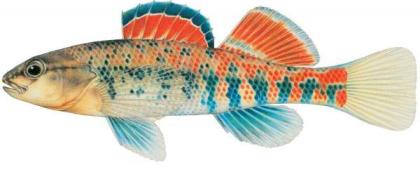Nutrition
Feeding Style
As pointed out in a study by Jeff Scott Wesner (2010), the
orangethroat darter (Etheostoma spectabile) is primarily an
invertivore. The term invertivore is used to classify organisms
which feed on organisms lacking vertebrae (Fish Base, 2013). The
orangethroat darter (Etheostoma spectabile), like many river and
stream fish of North America, is a benthic species (Wesner,
2010). Benthic is a term which refers to the plants, animals
and other organisms which are found on the beds of rivers,
streams or other bodies of water (Houghton, 169). Orangethroat
darters find and eat small invertebrates by sifting and picking
through the rocky, gravel based river bed, finding small
organisms here and there (Vogt and Coon, 1990). As David P.
Gillette (2012) observed and reported in a study, after darters
search for, locate, and consume their meals, the remainder of
the digestive process is completed within a 24 hour time span.

Diet
The orangethroat darter often preys on several families and
varieties of mayflies and caddisflies (Gillette, 2012). The
orangethroat darter is also known to prey on members of the
Dipteran family, which are a family of various flies, as well as
seed shrimp who are members of class Ostracoda (Gillette,
2012). Not only does the orangethroat darter feed on mature
Dipertans, but the Dipertan larval stages as well. In addition to Dipertan larvae, Ephemeropteran larvae and Trichopteran larval
forms are often consumed by orangethroat darters as well
(Gillette, 2012).
To generalize by genus, many small darters in the genus Etheostoma feed on microcrustaceans, whereas larger darters eat diets consisting mostly of immature insects (Cordes and Page, 1980).
___________________________________________________________________
